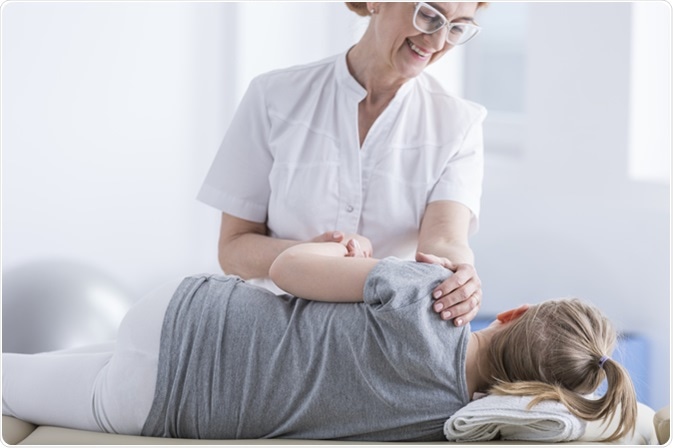Pediatric spinal deformities may occur in isolation, as part of a neuromuscular syndrome, or in association with congenital developmental defects. Whichever form it occurs in, it must be diagnosed as early as possible to prevent progression, cardiopulmonary compromise, and permanent deformity, as well as an unstable and painful spine.

Image Credit: Photographee.eu / Shutterstock
Classification of spinal deformities in children has thus followed several different pathways, ranging from a description of the anatomical curvature with respect to magnitude, number of curves and region of spine affected, to the comprehensive Lenke’s classification, which has good intra- and inter-observer reliability and helps to decide upon the level of fixation required.
However, whichever form it takes, a childhood deformity of the spine requires an early and accurate diagnosis to determine the proper and timely method of correction. This includes a thorough medical history and examination, with imaging procedures to provide a full picture of what is wrong with the spine, as well as accompanying defects, if any, in other organ-systems. This also makes sure that the baseline picture of the spinal deformity is obtained, which will enable further monitoring over the long term.
Clinical Features
The signs and symptoms of pediatric spinal deformities vary, but may include any or all of the following:
- Uneven levels of both shoulders
- Tilt of the head towards one side of the spine
- Tilt of the pelvis to one side of the body
- Limping or uneven gait due to a difference in hip levels
- Obvious hunchback deformity in kyphosis
- Breathing or cardiac difficulties due to the restricted and deformed thoracic cavity
- Lower back pain
- Humping of the chest on one side
- Delayed nerve conduction in advanced cases
These may occur in several conditions resulting in pediatric spinal deformity and are therefore non-specific, but suggestive features. They should be followed by a careful and detailed history of the patient, as well as of the family. A physical examination of the body and the whole spine will be performed, and a complete neurological examination to rule out neuromuscular conditions, which could cause scoliosis. Imaging tests will be ordered as indicated.
Dr Urbanek on Spinal Deformities in Children
Imaging tests useful in pediatric spinal deformity include:
- X-rays to reveal the spinal bones, any abnormalities in the spinal column, and the presence of curvature, if any, along with the angle of maximum curvature
- EOS imaging systems have been devised to create 3-dimensional images of the spine in an upright position, which helps to understand the spine curvature and effects of load-bearing better than the conventional CT or MRI scanning, which is done with the patient supine
- Computerized tomography (CT) scanning uses computerized assimilation of numerous low-dose X-ray images from all around the body to produce images of virtual cross-sections or slices of the body
- Magnetic resonance imaging (MRI) scanning uses magnetic fields, radiofrequency waves and computer programs to create a detailed depiction of the internal structure of the body without exposing the child to ionizing radiation. It is especially useful to rule out intraspinal pathologies, such as tethered cord, lipoma, or disease of the central nervous system like Chiari malformation.
- Dual-energy x-ray absorptiometry (DEXA) scans are bone scans to assess bone metabolism and bone health
- Positron emission tomography (PET) scanning uses radioisotopes to produce accurate pictures of the areas where it is concentrated, helping to rule out malignancy
- Ultrasound imaging is a non-ionizing means of assessing soft tissues
Other tests include pulmonary function tests to evaluate the impact of the spinal deformity on the child’s lungs and thoracic cavity, which would help determine the type of intervention needed. Imaging may also be needed to rule out anomalies in the spine, such as diastematomyelia or stenosis. Defects in other organs should also be searched for, using ultrasound to evaluate the heart or the kidneys, and MRI of the central nervous system (CNS) and spinal cord, especially if the deformity is due to a congenital malformation. This is because 30-50% of such cases are associated with neuraxis (i.e. axis of the CNS) anomalies. The latter is sometimes signaled by one of the following:
- A midline hair-bearing patch or dimple of the skin
- Asymmetrical malformations of the feet
- Weak or spastic muscles
- Abnormal sight or hearing
This type of testing is essential to find any hidden spinal cord pathology in patients with congenital spine anomalies. However, it may be restricted to those with actual focal neurological defect, progression of the spinal deformity, or if needed to plan the surgery.
References
Further Reading
Last Updated: Dec 29, 2022